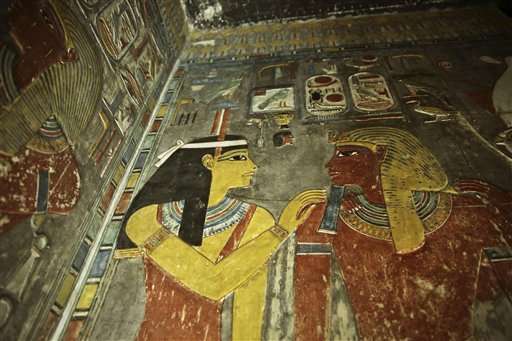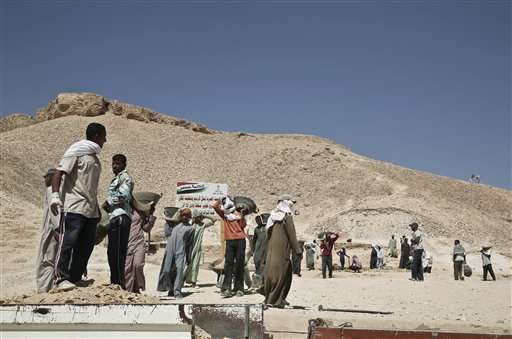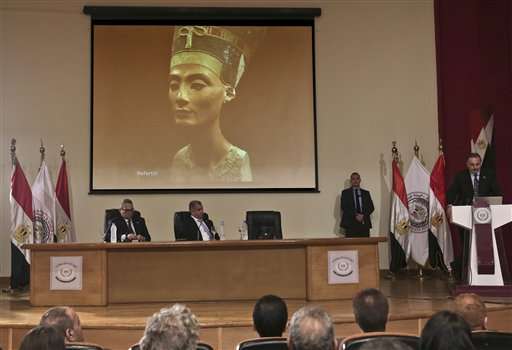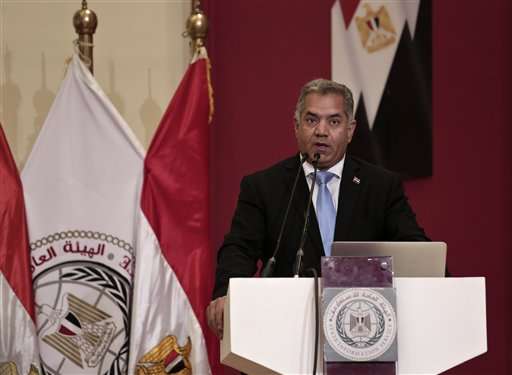Carvings are seen on a wall at the Horemheb tomb in the Valley of the Kings in Luxor, Egypt, Tuesday, Sept. 29, 2015. Egypt's antiquities minister said King Tut's tomb may contain hidden chambers, lending support to a British Egyptologist's theory that a queen may be buried in the walls of the 3,300 year-old pharaonic mausoleum. (AP Photo/Nariman El-Mofty)
Egyptian authorities promised Thursday they would move quickly to get new radar equipment needed to search for Queen Nefertiti's tomb amid a new theory it could be in an alleged, hidden chamber behind King Tutankhamun's tomb in the famed Valley of the Kings.
The theory, presented this summer by British Egyptologist Nicholas Reeves, speculates that King Tut, who died at the age of 19, may have been rushed into an outer chamber of what was originally Nefertiti's tomb.
Archeologists have yet to find the tomb of Queen Nefertiti, fabled for her beauty and famous since her bust was discovered in 1912, now on display at the Neues Museum in Berlin.
Since the 1922 discovery of King Tut's 3,300 year-old pharaonic mausoleum in the Valley of the Kings near the city of Luxor, his tomb has become the focus of attention for archaeologists world over—and one of Egypt's prime tourist draws in modern times.
Now, Reeves believes the walls of King Tut's tomb could conceal two unexplored doorways, one of which perhaps leads to Nefertiti's tomb. His theory has reinvigorated the search for Nefertiti, who was also the primary wife of Pharaoh Akhenaten, widely believed to have been Tut's father.
Reeves also speculates that—if he's right—the hidden chamber could hold undiscovered artifacts that could be even more stunning than those from Tut's tomb.
Antiquities Minister Mamdouh el-Damaty told reporters in Cairo that a plan would be presented "immediately" for non-invasive radar equipment.
Once approved, the equipment could be obtained and be at the site within three months, he said, or perhaps as early as November, for the 93rd anniversary of the 1922 discovery of Tut's tomb.
The radar equipment "will confirm whether there's something" there, said el-Damaty, who spoke after a joint visit this week with Reeves to the Valley of the Kings and King Tut's tomb.
-
Egyptian laborers work at the entrance of the Valley of the Kings in Luxor, Egypt, Tuesday, Sept. 29, 2015. Egypt's antiquities minister said King Tut's tomb may contain hidden chambers, lending support to a British Egyptologist's theory that a queen may be buried in the walls of the 3,300 year-old pharaonic mausoleum. Partial translation of the Arabic sign reads, "Long live Egypt, the Egyptian expedition is working on fixing and cleaning the area, part of a project to develop the Valley of the Kings." (AP Photo/Nariman El-Mofty)
-
Nicholas Reeves, a British Egyptologist affiliated to the Egyptian expedition at the University of Arizona, right, speaks during a press conference with Egypt's Antiquities Minister Mamdouh el-Damaty, center, in Cairo, Egypt, Thursday, Oct. 1, 2015. Egyptian authorities promised Thursday they will move quickly to get new radar equipment needed to search for Queen Nefertiti's tomb amid a new theory it could be in an alleged, hidden chamber behind King Tutankhamun's tomb in the famed Valley of the Kings. (AP Photo/Nariman El-Mofty)
-
Egypt's Antiquities Minister Mamdouh el-Damaty, speaks during a press conference in Cairo, Egypt, Thursday, Oct. 1, 2015. Egyptian authorities promised Thursday they will move quickly to get new radar equipment needed to search for Queen Nefertiti's tomb amid a new theory it could be in an alleged, hidden chamber behind King Tutankhamun's tomb in the famed Valley of the Kings. (AP Photo/Nariman El-Mofty)
© 2015 The Associated Press. All rights reserved.


























